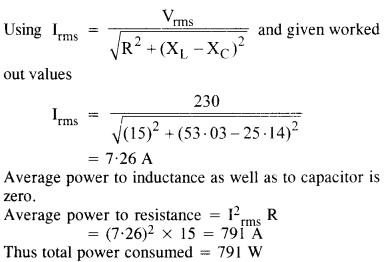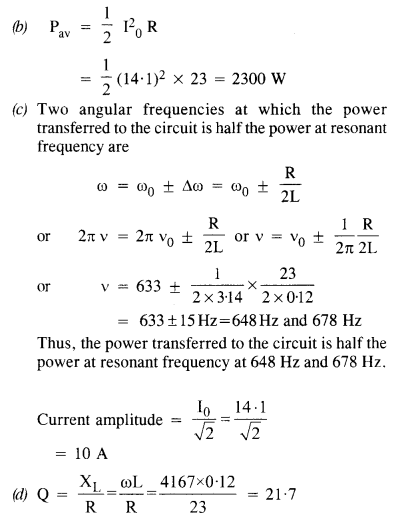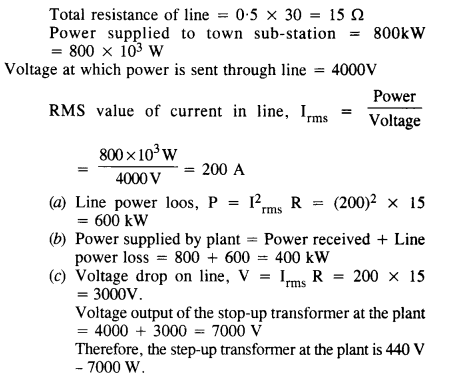NCERT Solved Exercise Questions – Class 12 Physics Chapter 7 Alternating Current
7.1 A 100 Ω resistor is connected to a 220 V, 50 Hz ac supply.
(a) What is the rms value of current in the circuit?
(b) What is the net power consumed over a full cycle?
Ans – Here, the virtual a.c. voltage is 220 V with a 50 Hz frequency. So, the current rms value

7.2 (a) The peak voltage of an ac supply is 300 V. What is the rms voltage?
(b) The rms value of current in an ac circuit is 10 A. What is the peak current?
Ans – Peak voltage , V0 = 300 V

7.3 A 44 mH inductor is connected to 220 V, 50 Hz ac supply. Determine the rms value of the current in the circuit.
Ans – : The inductor’s inductance is L = 44 m H = 44 10 – 3 H.
Source voltage, V = 220 V
Source frequency, v = 50 Hz
Source’s angular frequency, = 2

7.4 A 60 µF capacitor is connected to a 110 V, 60 Hz ac supply. Determine the rms value of the current in the circuit.
Ans – Capacitance of capacitor, C = 60 μF = 60 × 10−6 F
Supply voltage, V = 110 V

7.5 In Exercises 7.3 and 7.4, what is the net power absorbed by each circuit over a complete cycle. Explain your answer.
Ans – There is no power loss in the case of a perfect inductor or capacitor.
7.6 Obtain the resonant frequency ωr of a series LCR circuit with L = 2.0H, C = 32 µF and R = 10 Ω. What is the Q-value of this circuit?
Ans – Inductance, L = 2.0 H
Capacitance, C = 32 μF = 32 × 10−6 F

7.7 A charged 30 µF capacitor is connected to a 27 mH inductor. What is the angular frequency of free oscillations of the circuit?
Ans – Capacitance, C = 30μF = 30×10−6F
Inductance, L = 27 mH = 27 × 10−3 H

7.8 Suppose the initial charge on the capacitor in Exercise 7.7 is 6 mC. What is the total energy stored in the circuit initially? What is the total energy at later time?
Ans – The capacitor’s capacitance is 30 F (30 ×10 -6 F).
The inductor’s inductance is 27 mH, or 27 x10-3 H.
Charge applied to the capacitor: Q = 6 mC = 6 x10-3 C
The relation can be used to compute the total amount of energy held by the capacitor.

7.9 A series LCR circuit with R = 20 Ω, L = 1.5 H and C = 35 µF is connected to a variable-frequency 200 V ac supply. When the frequency of the supply equals the natural frequency of the circuit, what is the average power transferred to the circuit in one complete cycle?
Ans – When an LCR circuit is in resonance, the supply power’s frequency matches the LCR circuit’s inherent frequency.
R = 20 is the resistance.
L = 1.5 H Inductance

7.10 A radio can tune over the frequency range of a portion of MW broadcast band: (800 kHz to 1200 kHz). If its LC circuit has an effective inductance of 200 µH, what must be the range of its variable capacitor? [Hint: For tuning, the natural frequency i.e., the frequency of free oscillations of the LC circuit should be equal to the frequency of the radiowave.]
Ans – A radio’s frequency (v) spans the 800 kHz to 1200 kHz range.
1 = 800 kHz = 800 x103 Hz is a lower tuning frequency.
Upper tuning frequency: 1200 kHz/2 = 103 Hz (1200 kHz/2 = 1200).
Circuit’s effective inductance is 200 H, or 200 x10-6 H.

7.11 Figure 7.21 shows a series LCR circuit connected to a variable frequency 230 V source. L = 5.0 H, C = 80µF, R = 40 Ω.

(a) Determine the source frequency which drives the circuit in resonance.
(b) Obtain the impedance of the circuit and the amplitude of current at the resonating frequency.
(c) Determine the rms potential drops across the three elements of the circuit. Show that the potential drop across the LC combination is zero at the resonating frequency.
Ans – The inductor’s inductance is L = 5.0 H.
The capacitor’s capacitance is 80 F, or 80 x10-6 F.
R = 40 is the resistor’s resistance.
Potential of the source of fluctuating voltage, V = 230 V

7.12 An LC circuit contains a 20 mH inductor and a 50 µF capacitor with an initial charge of 10 mC. The resistance of the circuit is negligible. Let the instant the circuit is closed be t = 0.
(a) What is the total energy stored initially? Is it conserved during LC oscillations?
(b) What is the natural frequency of the circuit?
(c) At what time is the energy stored
(i) completely electrical (i.e., stored in the capacitor)?
(ii) completely magnetic (i.e., stored in the inductor)?
(d) At what times is the total energy shared equally between the inductor and the capacitor?
(e) If a resistor is inserted in the circuit, how much energy is eventually dissipated as heat?
Ans – The inductor’s inductance is 20 mH (20 x10-3 H).
The capacitor’s capacitance is 50 F, or 50x 10-6 F.
Capacitor initial charge: Q = 10 mC = 10 x10- 3 C


7.13 A coil of inductance 0.50 H and resistance 100 Ω is connected to a 240 V, 50 Hz ac supply.
(a) What is the maximum current in the coil?
(b) What is the time lag between the voltage maximum and the current maximum?
Ans –
nductance of the inductor, L = 0.50 H
Resistance of the resistor, R = 100 Ω
Potential of the supply voltage, V = 240 V

7.14 Obtain the answers (a) to (b) in Exercise 7.13 if the circuit is connected to a high frequency supply (240 V, 10 kHz). Hence, explain the statement that at very high frequency, an inductor in a circuit nearly amounts to an open circuit. How does an inductor behave in a dc circuit after the steady state?
Ans –
It can be inferred that an inductor behaves like an open circuit at high frequencies because
= 2 v = 2 x 104 rad s-1,
in this case, is too tiny.
Since v = 0 in a steady d.c. circuit, the inductor functions as a straightforward conductor.
7.15 A 100 µF capacitor in series with a 40 Ω resistance is connected to a 110 V, 60 Hz supply.
(a) What is the maximum current in the circuit?
(b) What is the time lag between the current maximum and the voltage maximum?
Ans – The capacitor’s capacitance is C = 100 F = 100 x10-6 F.
R = 40 is the resistor’s resistance.
Voltage of supply, V = 110 V

7.16 Obtain the answers to (a) and (b) in Exercise 7.15 if the circuit is connected to a 110 V, 12 kHz supply?
Hence, explain the statement that a capacitor is a conductor at very high frequencies. Compare this behaviour with that of a capacitor in a dc circuit after the steady state.
Ans –
The capacitor’s capacitance is C = 100 F = 100 x10-6 F.
R = 40 is the resistor’s resistance.
Voltage of supply, V = 110 V

7.17 Keeping the source frequency equal to the resonating frequency of the series LCR circuit, if the three elements, L, C and R are arranged in parallel, show that the total current in the parallel LCR circuit is minimum at this frequency. Obtain the current rms value in each branch of the circuit for the elements and source specified in Exercise 7.11 for this frequency.
Ans – In a circuit, an inductor (L), capacitor (C), and resistor (R) are linked in parallel with one another.
L = 5.0 H

7.18 A circuit containing a 80 mH inductor and a 60 µF capacitor in series is connected to a 230 V, 50 Hz supply. The resistance of the circuit is negligible.
(a) Obtain the current amplitude and rms values.
(b) Obtain the rms values of potential drops across each element.
(c) What is the average power transferred to the inductor?
(d) What is the average power transferred to the capacitor?
(e) What is the total average power absorbed by the circuit? [‘Average’ implies ‘averaged over one cycle’.]
Ans – L = 80 mH = 80 x10-3 H inductance
Capacitance, C = 60 x10-6 F = 60
A supply voltage of 230 volts.

7.19 Suppose the circuit in Exercise 7.18 has a resistance of 15 Ω. Obtain the average power transferred to each element of the circuit, and the total power absorbed.
Ans – 788.44 W is the average power delivered to the resistor.
Average power to the capacitor transferred is 0 W.
788.44 W is the total power absorbed by the circuit.

7.20 A series LCR circuit with L = 0.12 H, C = 480 nF, R = 23 Ω is connected to a 230 V variable frequency supply.
(a) What is the source frequency for which current amplitude is maximum. Obtain this maximum value.
(b) What is the source frequency for which average power absorbed by the circuit is maximum. Obtain the value of this maximum power.
(c) For which frequencies of the source is the power transferred to the circuit half the power at resonant frequency? What is the current amplitude at these frequencies?
(d) What is the Q-factor of the given circuit?
Ans – L = 0.12 H for inductance
Capacitance is defined as C = 480 nF = 480 x10-9 F.
R = 23 is the resistance.
A supply voltage of 230 volts.


7.21 Obtain the resonant frequency and Q-factor of a series LCR circuit with L = 3.0 H, C = 27 µF, and R = 7.4 Ω. It is desired to improve the sharpness of the resonance of the circuit by reducing its ‘full width at half maximum’ by a factor of 2. Suggest a suitable way.
Ans –Inductance, L = 3.0 H
27 F = 27 106 F Capacitance
Resistivity, R, is 7.4.
For the specified LCR series circuit, the source’s angular frequency at resonance is given as:

7.22 Answer the following questions:
(a) In any ac circuit, is the applied instantaneous voltage equal to the algebraic sum of the instantaneous voltages across the series elements of the circuit? Is the same true for rms voltage?
(b) A capacitor is used in the primary circuit of an induction coil. (c) An applied voltage signal consists of a superposition of a dc voltage and an ac voltage of high frequency. The circuit consists of an inductor and a capacitor in series. Show that the dc signal will appear across C and the ac signal across L.
(d) A choke coil in series with a lamp is connected to a dc line. The lamp is seen to shine brightly. Insertion of an iron core in the choke causes no change in the lamp’s brightness. Predict the corresponding observations if the connection is to an ac line.
(e) Why is choke coil needed in the use of fluorescent tubes with ac mains? Why can we not use an ordinary resistor instead of the choke coil?
Ans – (A) The instantaneous voltage that is being applied is equal to the algebraic sum of the instantaneous voltages across the circuit’s series components. It is as a result of an out of phase voltage across several elements.
For rms voltages, it is untrue. The reason for this is that the rms voltages across the various elements are out of phase.
(b) A significant induced emf is generated at the break. Sparking will occur if the capacitor is not connected. However, when the capacitor is used, the significant induced emf generated during break is consumed during capacitor charging and no sparking occurs.
(c) The dc signal will emerge across capacitor C because the impedance of a capacitor (C) is much higher than that of an inductor (L) for dc signals (almost infinite). A dc signal consequently arises over C. The impedance of L is high and that of C is relatively low for a high frequency ac signal. As a result, L is affected by a high frequency ac signal.
(d) The inductor does not inhibit the d.c. Since XL = 0, the iron core’s insertion has no impact on the d.c. current or linked lamp’s brightness. But the a.c. is undoubtedly affected. Current increases as the iron core is inserted, increasing L = m nl and XL (2L). A.c. IP = EXL decreases due to a reduction in current in the E circuit, and the bulb’s brightness does too.
(e) If a fluorescent tube is connected directly across a 220 V source, it will draw a significant amount of current and could potentially harm the filaments. Therefore, a choke coil that operates as an L-R circuit decreases the current to the proper value while also causing reduced power loss.
7.23 A power transmission line feeds input power at 2300 V to a stepdown transformer with its primary windings having 4000 turns. What should be the number of turns in the secondary in order to get output power at 230 V?
Ans – Voltage at input, V1 = 2300
4000 is the primary coil’s n1 turn count.
Voltage at output, V2 = 230 V

7.24 At a hydroelectric power plant, the water pressure head is at a height of 300 m and the water flow available is 100 m3 s –1. If the turbine generator efficiency is 60%, estimate the electric power available from the plant (g = 9.8 ms–2 ).
Ans – 300 m is the height of the water pressure head.
100 m3/s is the volume of water that flows each second.
Turbine generating efficiency, n = 60% = 0.6
Gravitational acceleration: g = 9.8 m/s2.

7.25 A small town with a demand of 800 kW of electric power at 220 V is situated 15 km away from an electric plant generating power at 440 V. The resistance of the two wire line carrying power is 0.5 Ω per km. The town gets power from the line through a 4000-220 V step-down transformer at a sub-station in the town.
(a) Estimate the line power loss in the form of heat.
(b) How much power must the plant supply, assuming there is negligible power loss due to leakage?
(c) Characterise the step up transformer at the plant.
Ans – The total amount of electricity needed is 800 kW, or 800 103 W.
Voltage of supply, V = 220 V
V’ = 440 V is the voltage at which the electric plant is generating power.
d = 15 km is the distance between the town and the power plant.

7.26 Do the same exercise as above with the replacement of the earlier transformer by a 40,000-220 V step-down transformer (Neglect, as before, leakage losses though this may not be a good assumption any longer because of the very high voltage transmission involved). Hence, explain why high voltage transmission is preferred?
Ans – A step-down transformer has a 40000 V–220 V rating.
Voltage at input, V1 = 40000 V
V2 = the output voltage in volts
The total amount of electricity needed is 800 kW, or 800 x103 W.
V = 220 V Source Potential





